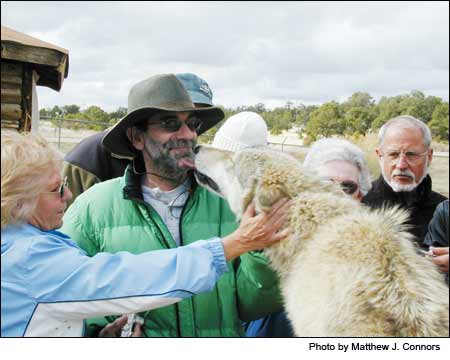 HOWL! Wild Spirit Wolf Sanctuary
HOWL! Wild Spirit Wolf Sanctuary Have you ever gone inside the bathroom of your local bar and noticed how the locals leave their mark on the bathroom walls?
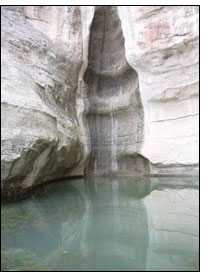 The messages left in such modern “watering holes” can be as simple as a name, a phone number or elaborate as a poem. They can also be outlets of jealousy as well as a lurid directory of contact information.
The messages left in such modern “watering holes” can be as simple as a name, a phone number or elaborate as a poem. They can also be outlets of jealousy as well as a lurid directory of contact information.
Similarly, Inscription Rock, located in El Morrow National Monument, 125 miles west of Albuquerque, bears the petroglyphs, names and cryptic messages left by Zuni Indians, explorers, soldiers and others. I recently saw these inscriptions during a field trip organized by UNM’s Continuing Education “Explore New Mexico” program.
There is a very fine watering hole at El Morrow, which helps explain its popularity throughout the ages. Situated at ground level beneath soaring, unstable cliffs, this 12’ deep pond has served as a relief station for generations of thirsty people and critters. Travellers could stop and fill up their canteen and if they had animal transportation they could rest and rehydrate as well.
the ages. Situated at ground level beneath soaring, unstable cliffs, this 12’ deep pond has served as a relief station for generations of thirsty people and critters. Travellers could stop and fill up their canteen and if they had animal transportation they could rest and rehydrate as well.
The surface of Inscription Rock is made of limestone and its surface is so soft that it can be easily carved. Two large limestone boulders are placed in front of the visitor’s center if you (or your kids) insist on leaving your mark (because it is against the law to deface the surface of Inscription Rock!)
As a person who has spent his life dedicated to the preservation of the printed word, I was absolutely fascinated by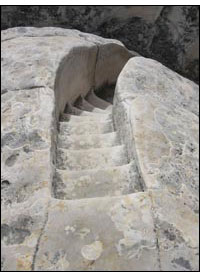 some of the delicate inscriptions that I saw.
some of the delicate inscriptions that I saw.
Way at the top of Monument Peak are the ruins of a 2,000-year-old pueblo where thousands of Indians once lived in a structure three stories tall. The walk to the top of Monument Peak is a hard one and should only be attempted by those in reasonably good shape.
When I climbed Monument Peak, the weather was rainy and overcast but there was no lightning. A bottle of water kept me hydrated and I was able to reach the ruins in about an hour.
The trail is a masterpiece of engineering, using paved switchbacks, oftentimes lined with rock at critical junctures. This trail gets you to the top of Monument Peak in record time and gives you plenty of Kodak moments. 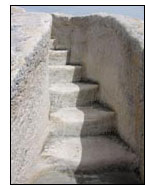
The limestone formations at the top of the peak are like nothing I have ever seen before. Embedded in the rock I saw beautiful swirls, and its texture is wavy and fluid, unlike the black, sharp-edged volcanic stuff that I have become accustomed to seeing in this region.
The trail is well marked by simple rock formations that intuitively point you along a large circular path that can make you an expert about El Morrow in as little as three hours.
During the Depression, somebody in the Works Project Administration (WPA) etched the boundaries of the 3’ 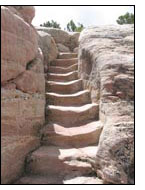 trail itself into the limestone rock that caps the monument. Using an eyedropper and a vial of acid, they created a very discreet trail along the smooth rock. Conventional trail markers are nowhere to be seen and this, I strongly believe, is one of the monument's greatest assets.
trail itself into the limestone rock that caps the monument. Using an eyedropper and a vial of acid, they created a very discreet trail along the smooth rock. Conventional trail markers are nowhere to be seen and this, I strongly believe, is one of the monument's greatest assets.
Some of my favorite sights were actually the graceful staircases that had been carved into the rock by the WPA. The ranger had to remind me that Indians did not carve them, although they certainly look like they had been there since the beginning of time.

A visit to the Wild Spirit Wolf Sanctuary 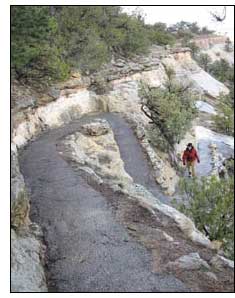 complemented my field trip to El Morrow. Located South of Gallup, near Ramah, New Mexico, its mission is “to provide permanent, safe sanctuary for abused and abandoned captive-bred wolves and wolf dogs.”
complemented my field trip to El Morrow. Located South of Gallup, near Ramah, New Mexico, its mission is “to provide permanent, safe sanctuary for abused and abandoned captive-bred wolves and wolf dogs.”
After assembling our group, we were led to a variety of enormous pens that housed wolves and wolf dogs. It turns out that the genetics of wolves and dogs are so similar that the only true way to tell them from each other is by observing their behavior.
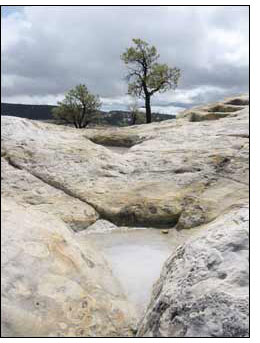 Dogs tend to be more pack-oriented whereas wolves are more solitary creatures. The tail of a wolf is straight and not curled.
Dogs tend to be more pack-oriented whereas wolves are more solitary creatures. The tail of a wolf is straight and not curled.
Wolves have developed a bad reputation over the years but there have only been two documented cases of a wolf ever attacking a human.
The wolves appear to be as happy as can be in their cages. They get fed human-grade raw meat that is purchased from grocery stores or donated by butchers.
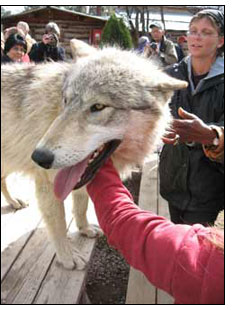 For the most part the wolves seem very timid around people.
For the most part the wolves seem very timid around people.
And then I met Dakota, a pure wolf who acts as the ambassador for the sanctuary. Dakota travels to schools and patiently endures the pets of as many as 40 first graders at the same time.
After getting a quick tour of the sanctuary, our tour leader encouraged us to howl, which in turn got all the wolves in the sanctuary mournfully howling. It was a chilling experience but I left feeling quite good because I had befriended Dakota, a wolf who licked my face all over!
Many misconceptions about wolves were, of course, shattered by my visit to the Wolf Reserve. I was saddened to learn that the reserve gets seven phone calls a day from people who can no lon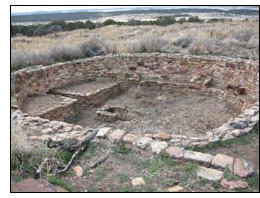 ger handle their wolf dogs. Unfortunately most requests cannot be accommodated due to lack of space and resources.
ger handle their wolf dogs. Unfortunately most requests cannot be accommodated due to lack of space and resources.
If you would like to sponsor a wolf or learn more about wolves and wolf dogs, be sure to visit their web site at www.wildspiritwolfsanctuary.org
Thank you for visiting Chucksville.
|
|


